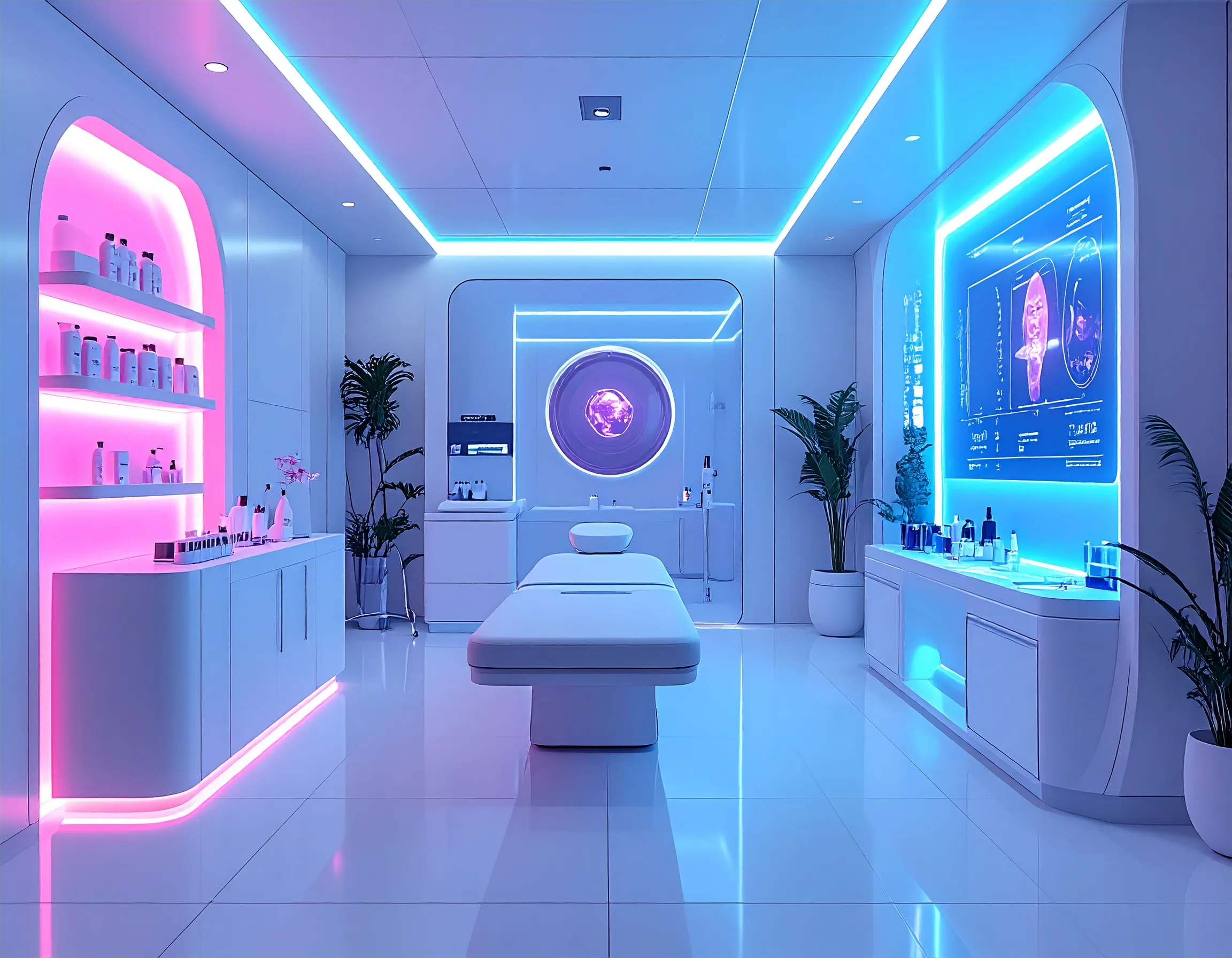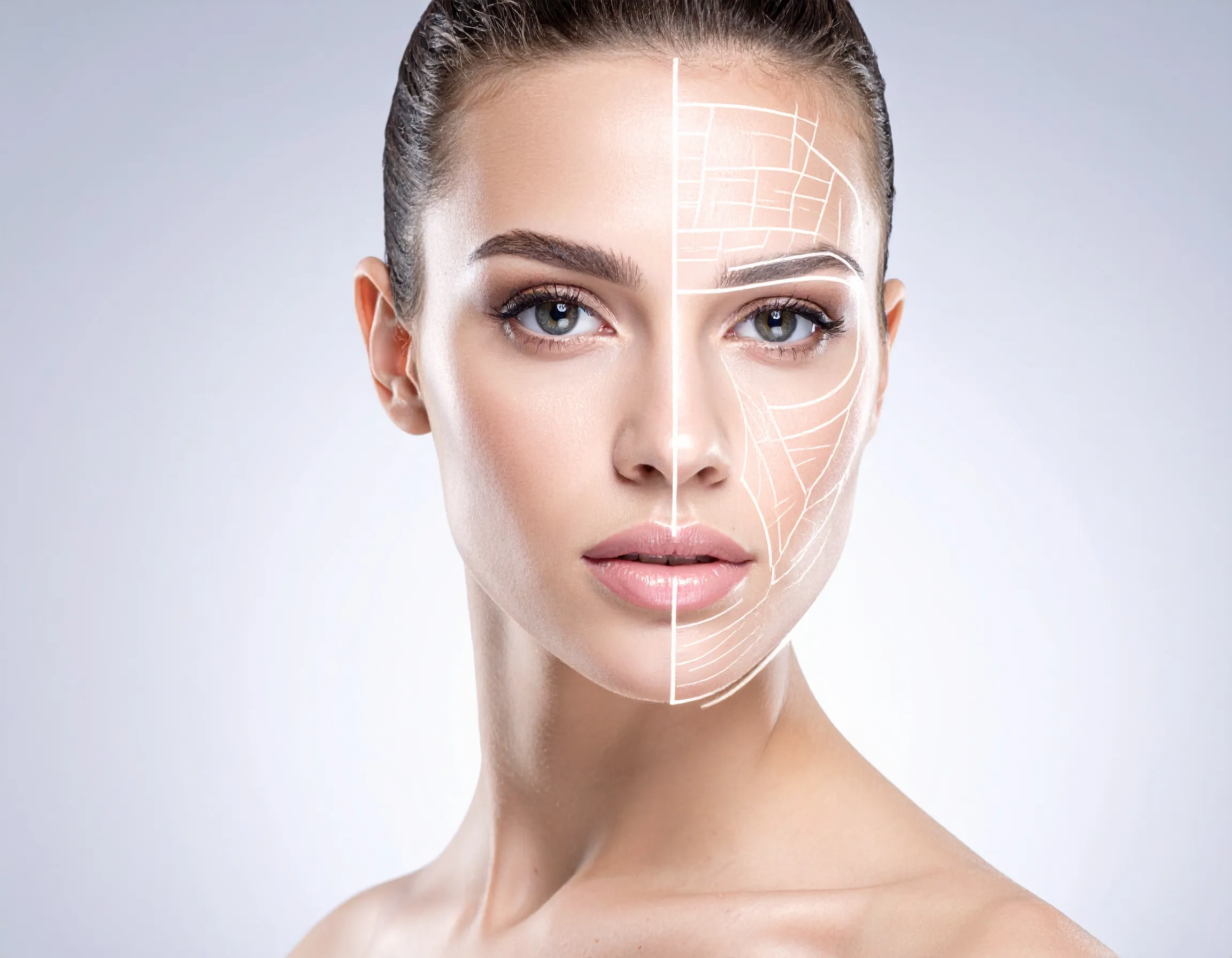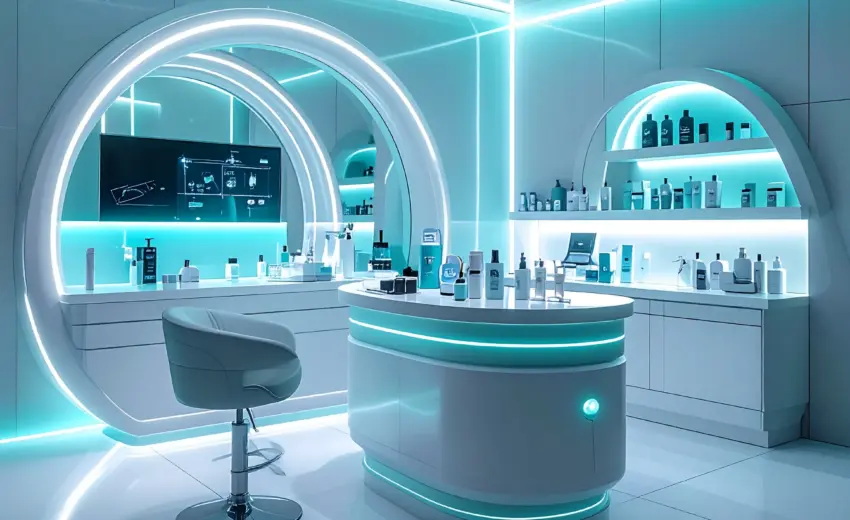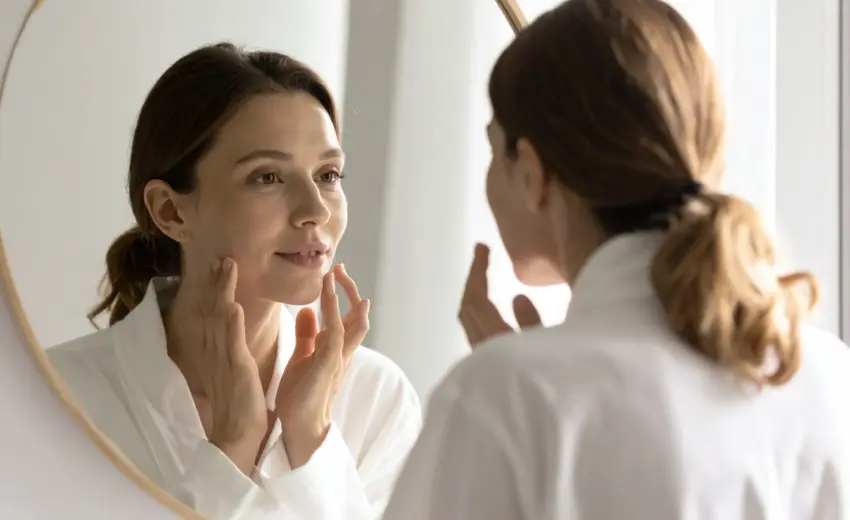Red light therapy benefits have been scientifically validated with impressive results. Studies show that after three months of Quantum RF treatment, patients experienced 70% to 75% improvements in skin tightening. This cutting-edge, non-invasive procedure uses radiofrequency energy to help achieve a naturally sculpted and refreshed appearance.
Furthermore, clinical research involving 136 volunteers confirmed significant improvements in skin complexion, texture, and ultrasonographically measured collagen density compared to control groups. The increased collagen production helps restore skin firmness and reduce the appearance of wrinkles or sagging skin. Additionally, many patients enjoy these remarkable effects for up to one to two years.
In this article, we’ll explore how red light therapy works, particularly when combined with radiofrequency in Quantum RF treatments. We’ll examine the scientific evidence behind its collagen-boosting abilities and discuss what you can realistically expect from this innovative skin rejuvenation approach. Whether you’re considering your first treatment or simply curious about the science, this comprehensive guide will help you understand why this therapy has gained such popularity for skin enhancement.
What is Red Light Therapy and How Does Quantum RF Fit In?
Red light therapy has emerged as a non-invasive therapeutic technique that uses specific wavelengths of light to treat various skin conditions. This approach employs low-level wavelengths of red light between 630 to 700 nanometers to stimulate cellular function without generating heat or damaging the skin’s surface. The process works through photobiomodulation, where light energy penetrates the skin and activates the cell’s energy source: mitochondria.
Definition of red light therapy and RF therapy
Red light therapy (RLT) effectively targets chromophores—light-sensitive components within cells—causing them to absorb light energy and transform it into signals that trigger specific biological functions. Once absorbed, this energy helps cells produce more adenosine triphosphate (ATP), essentially boosting cellular energy production. Consequently, cells can function more efficiently, rejuvenate faster, and repair themselves more effectively.
Radiofrequency (RF) therapy, on the other hand, utilizes high-frequency electromagnetic waves to generate controlled heat in deeper skin layers. Unlike RLT, which is a non-thermal biological modulation process, RF therapy works through physical stimulation driven primarily by thermal effects. The heat generated during RF treatment causes immediate collagen fiber contraction while simultaneously promoting the production of new collagen and elastin by fibroblasts.
How Quantum RF combines red light and radiofrequency
Quantum RF represents an innovative approach that merges these two distinct technologies. This combination creates a synergistic effect, where each modality enhances the overall therapeutic outcomes. The primary advantage lies in the multi-layered targeting capability—while RF energy reaches deep into the dermis without damaging the epidermis, red light handles the outermost skin layer by initiating biochemical reactions.
During a Quantum RF session, radiofrequency waves gently heat the skin to stimulate collagen production at its source. According to a 2008 study, exposure to radiofrequency increases collagen and elastin production for up to two months after treatment, resulting in thicker skin and improved appearance. Simultaneously, red LED light kick-starts internal processes by prompting a biochemical reaction that signals an increase in ATP and stimulates fibroblasts responsible for collagen production.
The thermal energy from RF can also prevent bacterial growth while the red light reduces inflammation and promotes tissue regeneration. This dual-action approach makes Quantum RF especially effective for addressing multiple skin concerns simultaneously.
Differences between Quantum RF and traditional LED masks
Traditional LED masks rely solely on light therapy without the thermal component of radiofrequency. The key differences include:
- Penetration depth: Traditional LED masks primarily affect the epidermis and superficial dermis, whereas Quantum RF targets multiple skin layers, reaching deeper tissues where collagen structures are found.
- Energy form: LED masks utilize non-thermal light energy, while Quantum RF combines this with heat from high-frequency currents.
- Results timeline: LED therapy typically requires multiple regular sessions (1-2 times weekly) for gradual results, whereas Quantum RF offers noticeable improvements after fewer sessions.
- Treatment focus: Traditional masks excel at addressing surface-level concerns like inflammation and mild texture issues, while Quantum RF is more effective for skin laxity, sagging, and deeper wrinkles.
For optimal outcomes, some practitioners recommend using both technologies—high-power red/infrared LED treatment can help optimize mitochondrial function and therefore enhance the effects of deep-acting RF treatment. This integrated approach delivers both immediate tightening effects and long-term collagen stimulation.

How Red Light Therapy Stimulates Collagen Production
The molecular mechanism behind red light therapy reveals an intricate biological process primarily acting on cellular energy systems. At its core, this therapeutic approach influences collagen production through several interconnected pathways that enhance skin structure and appearance.
Role of fibroblasts in collagen synthesis
Fibroblasts function as the primary architects of the skin’s structural framework. These specialized cells synthesize collagen, elastin, and other extracellular matrix components that maintain skin firmness and elasticity. As we age, fibroblast activity naturally decreases, contributing to the estimated 1% annual loss in dermal collagen content in adult skin.
Red light therapy significantly influences fibroblast behavior through multiple mechanisms. Studies have confirmed that exposing human skin cells to red and infrared light increases hyaluronic acid synthase, elastin, and collagen gene expression in fibroblasts within just 3 days. This effect extends beyond gene expression—treatment with red light therapy actively increases the synthesis of hyaluronic acid, collagen protein, and elastin protein in human fibroblasts.
Moreover, research demonstrates that specific wavelengths of red light stimulate fibroblast cell lines, leading to metabolic activation and increasing the synthesis of collagen, elastin, and hyaluronic acid. This process enhances the skin’s ability to maintain its structural integrity.
Thermal effects of RF on dermal layers
Radiofrequency energy generates controlled heat in dermal tissues, creating an additional pathway for collagen stimulation. When collagen fibers are heated, some cross-links break, causing the triple helix structure to partially unwind. This controlled thermal effect produces immediate collagen fiber contraction and thickening when cross-links are partially maintained.
Thermal stimulation, rather than thermal damage, is sufficient to achieve facial rejuvenation effects. In a clinical trial involving 46 patients, researchers confirmed that bipolar RF technology produces noticeable rejuvenating effects, especially on fine wrinkles, by thermally stimulating collagen within just 2 weeks.
The mechanism extends beyond immediate effects—RF treatment initiates a natural wound healing response in the skin, promoting new collagen formation via fibroblast activation and fibroplasia. Indeed, heat has been shown to induce collagen formation through heat shock protein 47 (HSP47) induction, a heat-sensitive protein directly related to collagen expression.
Wavelength range (600–850 nm) and tissue penetration
The effectiveness of red light therapy depends on its ability to reach target tissues at optimal depths. Light in the spectral range from 600 to 1300 nm demonstrates high penetration in skin tissues while being effectively absorbed by respiratory chain components.
Different wavelengths penetrate to varying depths:
- Red light at 630-660 nm penetrates approximately 1-4.5 mm into the skin
- Near-infrared light (780-980 nm) penetrates deeper, reaching up to 5 mm
A study examining human tissue penetration found that a 660 nm light at 100 mW/cm² intensity could penetrate tissues less than 50 mm thick. Notably, gender also affects light penetration, with females demonstrating greater tissue penetration than males.
ATP production and mitochondrial activation
The cornerstone of red light therapy’s effectiveness lies in its interaction with mitochondria, the cell’s powerhouses. Red and near-infrared light activates cytochrome c oxidase, a key enzyme in the mitochondrial electron transport chain. This activation increases mitochondrial ATP production, enhancing overall cellular metabolic activity.
Under stress conditions, nitric oxide can bind to cytochrome c oxidase, inhibiting its activity and reducing ATP production. Red light therapy helps displace this nitric oxide, allowing the enzyme to function more efficiently. The photons in red light excite electrons, breaking up nitric oxide bonds so hydrogen ions can move through the process more effectively, resulting in greater ATP energy production.
This enhanced energy availability powers various cellular processes, including increased collagen production. Research has shown that this pathway not only boosts fibroblast activity but also increases RNA and protein synthesis, oxygen consumption, and membrane potential. Furthermore, this process has been demonstrated to reverse collagen downregulation and MMP-1 upregulation, directly supporting skin rejuvenation.
Top 5 Red Light Therapy Benefits for Skin
Clinical studies consistently demonstrate the remarkable benefits of red light therapy for skin rejuvenation. Through carefully measured outcomes, researchers have documented specific improvements across multiple skin parameters.
Reduction in fine lines and wrinkles
Scientific evidence confirms that red light therapy significantly diminishes facial wrinkles. In one study, after just 28 days of treatment, researchers observed a 15.6% decrease in crow’s feet wrinkle depth, which further improved to 34.7% after 56 days and 38.3% after 84 days. Another investigation revealed that over 90% of individuals showed a reduction in rhytid depth following 12 LED treatments. Even more impressive, through blinded clinical assessment, 87% of participants experienced a reduction in the Fitzpatrick wrinkling severity score. These results demonstrate how effectively red light therapy addresses one of the most visible signs of aging.
Improved skin texture and tone
Beyond wrinkle reduction, red light therapy creates noticeable improvements in overall skin appearance. The therapy increases blood circulation and cellular turnover, subsequently evening out skin tone. Research participants commonly report smoother texture and brighter complexion. In fact, in one study, more than 90% of patients noted improvements including softer, smoother skin, reduced redness, and lightened dark spots after eight LED red-light treatments. These benefits arise from red light’s ability to reduce inflammation while promoting healing—making it suitable for sensitive or reactive skin conditions.
Increased collagen density (CIS metrics)
Perhaps most impressive are the measured increases in collagen density. High-resolution ultrasound examinations have revealed visible changes in collagen fiber density as measured by Collagen Intensity Scores (CIS). Studies document a remarkable 26.4% increase in dermal density after just 28 days of mask use, progressing to 41% after 56 days, and reaching 47.7% improvement after 84 days. For men specifically, despite their typically thicker skin, measurements showed an extraordinary 62.1% increase in dermal density following three months of treatment.
Firmer skin in face, neck, and arms
Clinical measurements confirm that red light therapy delivers substantial firming effects across multiple body areas. Subjects experienced a 5.4% reduction in facial oval sagging after 28 days, increasing to 24.8% after 84 days. Furthermore, measurements showed a 13.6% decrease in R0 values (indicating increased skin firmness) after one month, improving to 23.6% after three months. Since light therapy devices aren’t limited to facial applications, many patients successfully treat their necks, décolletages, and arms for comprehensive rejuvenation.
Reduction in skin roughness (Ra values)
Surface texture improvements have been objectively quantified through profilometry. Ra values, which measure skin roughness, showed a 6.8% decrease after 28 days, 18.2% after 56 days, and 23.8% after 84 days—representing progressive smoothing of the skin surface. Additionally, studies report up to a 28.5% decrease in pore diameter, further enhancing the smoothness effect. These improvements remained stable during follow-up assessments, with participants maintaining significantly better results at t60 (60 treatments) compared to baseline measurements.

What to Expect During a Quantum RF Session
Preparing for your first Quantum RF experience helps set realistic expectations about the process. Understanding the practical aspects of treatment can make your session more comfortable and effective.
Session duration and treatment frequency
Quantum RF sessions are typically efficient, lasting between 30 to 45 minutes depending on the treatment area. Some clinics offer shorter 15-minute sessions, while others may extend to 60 minutes for larger treatment zones. For optimal results, most practitioners recommend a series of 3 to 6 treatments spaced approximately 4 weeks apart. After completing your initial treatment series, maintenance sessions are generally scheduled once every 3 to 4 months to preserve the collagen-boosting benefits.
Use of cooling gel and comfort measures
Before beginning treatment, your provider will thoroughly cleanse the targeted area. Afterward, a conductive gel is applied—this critical component facilitates the transmission of radiofrequency energy while protecting your skin’s surface. Many clinics utilize specialized Radiofrequency Cooling Gel that prevents overheating yet allows skin to warm appropriately during treatment. For enhanced comfort, some practitioners apply topical numbing cream or local anesthetic, though many patients find the procedure comfortable without numbing. Throughout the session, you’ll typically experience a pleasant warming sensation without sharp pain.
Immediate vs delayed effects on skin
Initially, you may notice mild redness and warmth immediately after treatment, along with a tightening sensation from temporary edema. These effects generally subside within a few hours. The red light therapy benefits for skin continue developing long after your session ends. While some initial improvements may be visible shortly after treatment, the most significant changes typically emerge over weeks as collagen production increases. Full results develop gradually, with optimal outcomes appearing after 3-6 months. Clinical studies show this delayed response occurs because Quantum RF triggers natural collagen remodeling processes that continue working for months after treatment.
Before and After: Long-Term Results and Maintenance
Results from Quantum RF treatment develop gradually, with most patients observing noticeable improvements within the first few weeks. Although initial benefits may appear quickly, the truly impressive outcomes emerge throughout the treatment course and beyond.
Visible changes after 30 sessions
Within the first month, 86.67% of patients show measurable improvement, primarily in the 1-25% range for 61.67% of individuals. As treatments progress, the results become increasingly apparent. At the three-month mark, 85% of patients demonstrate visible enhancements, with 40% achieving moderate improvement (26-50% change) and 3.33% experiencing marked improvement (51-75% change).
Sustained collagen increase at 6-month follow-up
Remarkably, the benefits of Quantum RF continue developing long after the final session. Studies document steady improvements at the 1-, 3-, and 6-month follow-ups. By the 6-month checkpoint, 86.67% of patients maintain their improvements, with the majority (38.33%) showing moderate enhancement, 8.33% displaying marked improvement, and 3.33% achieving excellent results.
Maintenance treatment recommendations
For optimal longevity, periodic maintenance sessions help extend red light therapy benefits. Most practitioners suggest annual touch-up treatments, although individualized schedules vary based on skin condition, age, and lifestyle factors. While skin tightening effects typically last 12-18 months, fat reduction results can be permanent with proper lifestyle maintenance. Generally, 2-3 maintenance treatments spaced 3-6 months apart effectively preserve results.
Conclusion
Red light therapy combined with radiofrequency stands as a powerful approach to skin rejuvenation, backed by substantial scientific evidence. Throughout this article, we’ve explored how Quantum RF technology effectively stimulates collagen production through both photobiomodulation and controlled thermal effects. The dual-action mechanism penetrates multiple skin layers, addressing various concerns simultaneously while generating lasting improvements.
Results clearly demonstrate the effectiveness of this treatment. After consistent sessions, patients experience significant reductions in fine lines and wrinkles, alongside measurable improvements in skin texture and tone. Additionally, clinical measurements confirm remarkable increases in collagen density, with some studies showing up to 62.1% improvement in dermal density for men after three months.
Most compelling evidence supports the long-term nature of these benefits. Though you might notice initial improvements shortly after treatment, the most dramatic changes typically emerge gradually as your body’s natural collagen production increases. Therefore, patience proves essential when undergoing Quantum RF therapy, with optimal results generally appearing after 3-6 months.
Certainly, maintaining these impressive gains requires periodic follow-up sessions. While the primary effects typically last 12-18 months, scheduling maintenance treatments every 3-6 months helps preserve your rejuvenated appearance. This investment ultimately pays dividends through sustained skin firmness, smoothness, and overall youthful quality.
Above all, Quantum RF therapy offers a scientifically validated, non-invasive alternative to more aggressive treatments, providing natural-looking rejuvenation without extended downtime. The progressive improvement pattern aligns perfectly with how our bodies naturally heal and regenerate, creating results that not only look better but actually represent healthier, more resilient skin.
Key Takeaways
Red light therapy combined with radiofrequency technology offers scientifically-proven skin rejuvenation benefits through dual-action collagen stimulation mechanisms.
- Quantum RF delivers measurable results: Clinical studies show 70-75% improvements in skin tightening after three months, with up to 62.1% increase in dermal density.
- Dual-action mechanism maximizes effectiveness: Red light activates cellular ATP production while radiofrequency generates controlled heat, targeting multiple skin layers simultaneously.
- Results develop gradually over months: While initial improvements appear within weeks, optimal collagen remodeling effects emerge after 3-6 months of treatment.
- Long-term benefits require maintenance: Effects typically last 12-18 months, with periodic touch-up sessions every 3-6 months recommended to preserve results.
- Non-invasive alternative to aggressive treatments: Sessions last 30-45 minutes with minimal discomfort, offering natural-looking rejuvenation without extended downtime.
The combination of immediate thermal effects and sustained cellular activation makes Quantum RF particularly effective for addressing fine lines, skin texture, and firmness across face, neck, and arms. This evidence-based approach represents a significant advancement in non-surgical skin rejuvenation technology.
FAQs
Q1. How effective is red light therapy in stimulating collagen production? Red light therapy has been scientifically proven to boost collagen production significantly. Studies show that it increases collagen density by up to 47.7% after 84 days of treatment, with some men experiencing a remarkable 62.1% increase in dermal density after three months.
Q2. What are the main benefits of Quantum RF for skin rejuvenation? Quantum RF combines red light therapy with radiofrequency to provide multiple benefits, including reduction in fine lines and wrinkles, improved skin texture and tone, increased collagen density, firmer skin in the face, neck, and arms, and reduced skin roughness. These improvements are measurable and clinically proven.
Q3. How long does it take to see results from Quantum RF treatments? While some initial improvements may be visible shortly after treatment, the most significant changes typically emerge over weeks to months. Optimal results usually appear after 3-6 months as the body’s natural collagen remodeling processes continue working long after the treatment sessions.
Q4. Are the effects of Quantum RF treatment permanent? The effects of Quantum RF treatment are long-lasting but not permanent. Skin tightening effects typically last 12-18 months. To maintain optimal results, practitioners recommend periodic maintenance sessions, usually 2-3 treatments spaced 3-6 months apart.
Q5. What should I expect during a Quantum RF session? A typical Quantum RF session lasts between 30 to 45 minutes. Your provider will apply a conductive gel to facilitate energy transmission and protect your skin. You’ll experience a warming sensation during treatment, which is generally comfortable. Some mild redness and warmth may occur immediately after the session but usually subsides within a few hours.


